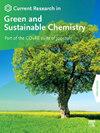Comparative analysis of the response surface methodology (RSM) and artificial neural network (ANN) modelling for the removal of diclofenac potassium from synthesized pharmaceutical wastewater using a palm sheath fiber nano-filtration membrane and optimization
Q2 Materials Science
Current Research in Green and Sustainable Chemistry
Pub Date : 2025-01-01
DOI:10.1016/j.crgsc.2025.100466
引用次数: 0
Abstract
Palm sheath fiber obtained from the petiole of palm tree leaf was defatted and characterized by X-ray diffraction (XRD), revealing a crystalline composition of 75 % calcite, 10.5 % quartz, 4 % periclase, and 10.2 % lime. Further analysis of pore area, volume, and diameter confirmed the membrane as an adsorptive nanofiltration material. A stock solution of Diclofenac potassium was prepared and was filtered varying four process factors: temperature (30–50 °C), pH (6–10), flow-rate (1–5 ml/min), and initial concentration (40–120 mg/L). The removal efficiency of Diclofenac Potassium was analyzed and compared using two optimization models; Methodology (RSM) and Artificial Neural Networks (ANN), focusing on the influence of these factors. The performance and sensitivity of these models were assessed using statistical metrics such as correlation coefficients (R2), Absolute Average Relative Deviation (AARD), and Mean Absolute Error (MAE). Both models demonstrated strong correlation with the experimental data, with the ANN model providing the best predictive accuracy. Optimization of the process via genetic algorithms yielded the optimal membrane removal efficiency of 84.78 %, achieved at initial concentration (102 mg/L), pH (8.8), temperature (40.6 °C), and flow rate (3.6 ml/min). The validation of these optimized parameters was carried out through triplicate experiments, resulting in an average confirmatory removal efficiency of 84.67 %, which validated the ANN prediction. Additionally, adsorption isotherm analysis revealed that the Dubinin-Radushkevich (D-R) model was the best fit for the experimental data, with an R2 value of 0.9839. The adsorption kinetics suggested that the process followed pseudo-first-order kinetics as the rate-limiting mechanism.
响应面法(RSM)和人工神经网络(ANN)模型对棕榈鞘纤维纳米过滤膜去除制药废水中双氯芬酸钾的影响对比分析及优化
对从棕榈叶柄中提取的棕榈鞘纤维进行脱脂和x射线衍射(XRD)表征,发现其晶体成分为75%方解石、10.5%石英、4%方解石和10.2%石灰。进一步的孔面积、体积和直径分析证实了该膜是一种吸附纳滤材料。制备双氯芬酸钾原液,通过温度(30-50℃)、pH(6-10)、流速(1-5 ml/min)、初始浓度(40-120 mg/L)四个工艺因素进行过滤。采用两种优化模型对双氯芬酸钾的去除率进行了分析比较;方法(RSM)和人工神经网络(ANN),重点研究这些因素的影响。使用相关系数(R2)、绝对平均相对偏差(AARD)和平均绝对误差(MAE)等统计指标评估这些模型的性能和灵敏度。两种模型均与实验数据具有较强的相关性,其中人工神经网络模型的预测精度最高。在初始浓度(102 mg/L)、pH(8.8)、温度(40.6°C)和流速(3.6 ml/min)下,通过遗传算法对工艺进行优化,获得了最佳的膜去除率为84.78%。通过三次实验对优化后的参数进行验证,平均验证去除效率为84.67%,验证了人工神经网络的预测结果。吸附等温线分析表明,Dubinin-Radushkevich (D-R)模型与实验数据拟合最佳,R2值为0.9839。吸附动力学表明,该过程遵循准一级动力学作为限速机制。
本文章由计算机程序翻译,如有差异,请以英文原文为准。
求助全文
约1分钟内获得全文
求助全文
来源期刊

Current Research in Green and Sustainable Chemistry
Materials Science-Materials Chemistry
CiteScore
11.20
自引率
0.00%
发文量
116
审稿时长
78 days
 求助内容:
求助内容: 应助结果提醒方式:
应助结果提醒方式:


